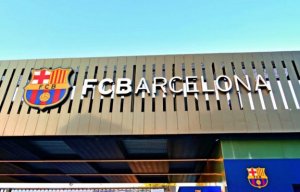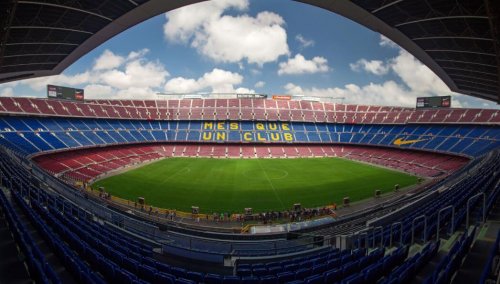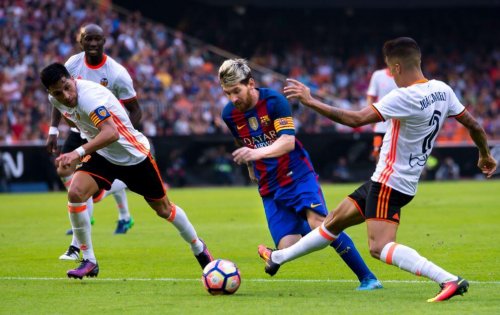FC Barcelona: Symbol of the Culture of Catalonia

The FC Barcelona, one of the greatest teams in soccer today, is an institution whose roots lie deep inside the heart of Catalonia. It was founded in 1899 and it’s now more than just a club, exactly as their fans chant in Catalan. Here, we’ll briefly review the club’s peculiar history and what makes it so different from other teams.
FC Barcelona started out at the end of the 19th century, when a Swiss man, by the name of Hans Gamper moved to Catalonia. He decided to establish a new sports institution. Hans, or Joan as he later became known, was only 22 years of age and he loved soccer. And so, he created a team that consisted of six foreigners and six nationals.
Despite not meeting the required age to be the president of the club, he was always linked to important decisions. In fact, many will agree that Gamper put money in from his own pocket during rough times.
And, consequently, it was money that caused his tragic death. Gamper committed suicide in 1930, due to a deep financial crisis that came as a consequence of the Great Depression. His death hit hard among locals in Barcelona, however, even today, he’s still a hero for the club and followers.

Years of glory and deep crisis
In 1922, FC Barcelona completed its first match at Camp de Les Corts, a stadium with a capacity for hosting 1000 spectators. And it was there where the club achieved its first titles: four Spanish Cups and the first League Cup, in 1929.
However, the club started representing a stronger social presence due to the political events at the time. In Catalonia, the Catalan Independence Movement represented the identity ideology that found strength in sports. Once, in 1925, Primo de Rivera closed the stadium for six months because fans booed over the Spanish national anthem.
The 1930s were perhaps the toughest part of the history of FC Barcelona. After the death of Gamper, the situation didn’t improve, in fact, it only became worse. In the 1933-1934 season, FC Barcelona would have fallen to the second division had the first division not expanded.
On the other hand, in the social and political scope, the Civil War hit FC Barcelona hard since it was part of the “rebel” land. Its own president at the time, Josep Sunyol, was a Catalan politician who the Franco regime assassinated.
In 1938, the bombing of Barcelona nearly completely destroyed the club’s headquarters. At the beginning of the decade, FC Barcelona had 12,000 members, by the end of it, there were only 2,000.
The revival of FC Barcelona
The 1940s saw a period of reconstruction for the club. Franco’s dictatorship elected the authorities up until 1953. Likewise, they translated all of the statutes to Spanish and the emblem lost the red and yellow stripes for nine years.
However, the 1950s brought much better luck for the club. One of the main characteristics of FC Barcelona is its Catalan spirit and also the importance that foreigners have had throughout its history. After Gamper, it was the Hungarian Ladislao Kubala who came to charm the club members.
As its president, FC Barcelona achieved three league titles in that decade, with more than 15 other contemporary titles. Due to a rise in members, the club built a new stadium, the famous “Camp Nou,” with a capacity for 93,000 people, in 1957.
On the other side of the country, Alfredo Di Stéfano was taking Real Madrid to its fifth consecutive European Cup. Coincidentally he didn’t make it to FC Barcelona because of a lack of confidence and a broken deal to switch other players.
The 1960s saw complications again for FC Barcelona. And so, the club only achieved four titles in that decade. The rivalry with Real Madrid became stronger as the team acquired more cups on their shelves.
The modern history of FC Barcelona
Since the 1970s, the club’s trajectory became more widely known. And so, in 1974 the club acquired Johan Cruyff. He was the star of the club, taking it to some of its best years, along with coach Rinus Michels.
In the 1980s, under the presidency of José Luis Nuñez, the club expanded the stadium and hired new star players such as Diego Maradona, Gary Lineker, and Bernd Schuster.
However, during that decade the club only gave its fans one league title and three Copa del Rey. They also lost the final of the Europe Cup in 1986 against Steaua from Bucharest.
“Football must always be played in an attractive way, you must play offensively, it must be a show”
– Johan Cruyff-
Johan Cruyff returned to Barcelona in 1988, but this time as a coach. That’s when the club developed a special style of game that it still uses today. And so, this was the same style that the Netherlands national team had in 1974. In 1992, FC Barcelona won their first continental cup, with Josep Guardiola as the star player.
The age of Guardiola
Although FC Barcelona has always been a great team in Europe, it was in 2008 that it truly became its best. This is now what everyone calls the Guardiola age, with “Pep” Guardiola as its coach.
The stars of this time were Lionel Messi, Carles Puyol, Andés Iniesta, and Xavi Hernández, among other great players. In the last decade, the club has achieved things that very few teams have managed to.

Three UEFA Champions League titles, three FIFA Club World Cups, six League titles, and five Copa del Rey titles. Although Guardiola was the coach until 2012, the following coaches have managed to increase those 14 titles since he left the club. Many argue that this might be the best team in the history of the sport.
After so much hardship and being overshadowed by Real Madrid and all of its titles, FC Barcelona has recovered its rightful place. It has beaten records with its outstanding teams, and it’s now a football reference worldwide. Thus, fans aren’t wrong when they chant that it’s more than a club.
The FC Barcelona, one of the greatest teams in soccer today, is an institution whose roots lie deep inside the heart of Catalonia. It was founded in 1899 and it’s now more than just a club, exactly as their fans chant in Catalan. Here, we’ll briefly review the club’s peculiar history and what makes it so different from other teams.
FC Barcelona started out at the end of the 19th century, when a Swiss man, by the name of Hans Gamper moved to Catalonia. He decided to establish a new sports institution. Hans, or Joan as he later became known, was only 22 years of age and he loved soccer. And so, he created a team that consisted of six foreigners and six nationals.
Despite not meeting the required age to be the president of the club, he was always linked to important decisions. In fact, many will agree that Gamper put money in from his own pocket during rough times.
And, consequently, it was money that caused his tragic death. Gamper committed suicide in 1930, due to a deep financial crisis that came as a consequence of the Great Depression. His death hit hard among locals in Barcelona, however, even today, he’s still a hero for the club and followers.

Years of glory and deep crisis
In 1922, FC Barcelona completed its first match at Camp de Les Corts, a stadium with a capacity for hosting 1000 spectators. And it was there where the club achieved its first titles: four Spanish Cups and the first League Cup, in 1929.
However, the club started representing a stronger social presence due to the political events at the time. In Catalonia, the Catalan Independence Movement represented the identity ideology that found strength in sports. Once, in 1925, Primo de Rivera closed the stadium for six months because fans booed over the Spanish national anthem.
The 1930s were perhaps the toughest part of the history of FC Barcelona. After the death of Gamper, the situation didn’t improve, in fact, it only became worse. In the 1933-1934 season, FC Barcelona would have fallen to the second division had the first division not expanded.
On the other hand, in the social and political scope, the Civil War hit FC Barcelona hard since it was part of the “rebel” land. Its own president at the time, Josep Sunyol, was a Catalan politician who the Franco regime assassinated.
In 1938, the bombing of Barcelona nearly completely destroyed the club’s headquarters. At the beginning of the decade, FC Barcelona had 12,000 members, by the end of it, there were only 2,000.
The revival of FC Barcelona
The 1940s saw a period of reconstruction for the club. Franco’s dictatorship elected the authorities up until 1953. Likewise, they translated all of the statutes to Spanish and the emblem lost the red and yellow stripes for nine years.
However, the 1950s brought much better luck for the club. One of the main characteristics of FC Barcelona is its Catalan spirit and also the importance that foreigners have had throughout its history. After Gamper, it was the Hungarian Ladislao Kubala who came to charm the club members.
As its president, FC Barcelona achieved three league titles in that decade, with more than 15 other contemporary titles. Due to a rise in members, the club built a new stadium, the famous “Camp Nou,” with a capacity for 93,000 people, in 1957.
On the other side of the country, Alfredo Di Stéfano was taking Real Madrid to its fifth consecutive European Cup. Coincidentally he didn’t make it to FC Barcelona because of a lack of confidence and a broken deal to switch other players.
The 1960s saw complications again for FC Barcelona. And so, the club only achieved four titles in that decade. The rivalry with Real Madrid became stronger as the team acquired more cups on their shelves.
The modern history of FC Barcelona
Since the 1970s, the club’s trajectory became more widely known. And so, in 1974 the club acquired Johan Cruyff. He was the star of the club, taking it to some of its best years, along with coach Rinus Michels.
In the 1980s, under the presidency of José Luis Nuñez, the club expanded the stadium and hired new star players such as Diego Maradona, Gary Lineker, and Bernd Schuster.
However, during that decade the club only gave its fans one league title and three Copa del Rey. They also lost the final of the Europe Cup in 1986 against Steaua from Bucharest.
“Football must always be played in an attractive way, you must play offensively, it must be a show”
– Johan Cruyff-
Johan Cruyff returned to Barcelona in 1988, but this time as a coach. That’s when the club developed a special style of game that it still uses today. And so, this was the same style that the Netherlands national team had in 1974. In 1992, FC Barcelona won their first continental cup, with Josep Guardiola as the star player.
The age of Guardiola
Although FC Barcelona has always been a great team in Europe, it was in 2008 that it truly became its best. This is now what everyone calls the Guardiola age, with “Pep” Guardiola as its coach.
The stars of this time were Lionel Messi, Carles Puyol, Andés Iniesta, and Xavi Hernández, among other great players. In the last decade, the club has achieved things that very few teams have managed to.

Three UEFA Champions League titles, three FIFA Club World Cups, six League titles, and five Copa del Rey titles. Although Guardiola was the coach until 2012, the following coaches have managed to increase those 14 titles since he left the club. Many argue that this might be the best team in the history of the sport.
After so much hardship and being overshadowed by Real Madrid and all of its titles, FC Barcelona has recovered its rightful place. It has beaten records with its outstanding teams, and it’s now a football reference worldwide. Thus, fans aren’t wrong when they chant that it’s more than a club.
This text is provided for informational purposes only and does not replace consultation with a professional. If in doubt, consult your specialist.








